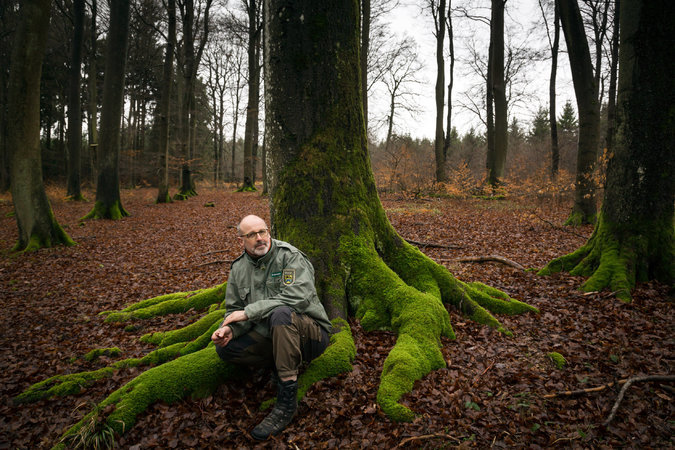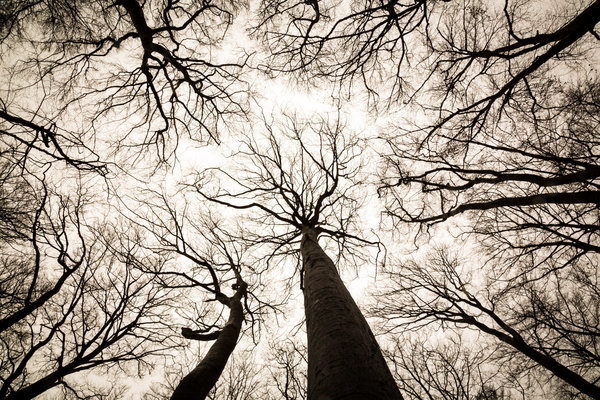
Before moving on to an elderly beech to show how trees, like people, wrinkle as they age, he added, "Sometimes, pairs like this are so interconnected at the roots that when one tree dies, the other one dies, too."
Mr. Wohlleben, 51, is a very tall career forest ranger who, with his ramrod posture and muted green uniform, looks a little like one of the sturdy beeches in the woods he cares for. Yet he is lately something of a sensation as a writer in Germany, a place where the forest has long played an outsize role in the cultural consciousness, in places like fairy tales, 20th-century philosophy, Nazi ideology and the birth of the modern environmental movement.

Presenting scientific research and his own observations in highly anthropomorphic terms, the matter-of-fact Mr. Wohlleben has delighted readers and talk-show audiences alike with the news — long known to biologists — that trees in the forest are social beings. They can count, learn and remember; nurse sick neighbors; warn each other of danger by sending electrical signals across a fungal network known as the "Wood Wide Web"; and, for reasons unknown, keep the ancient stumps of long-felled companions alive for centuries by feeding them a sugar solution through their roots.
"With his book, he changed the way I look at the forest forever," Markus Lanz, a popular talk show host, said in an email. "Every time I walk through a beautiful woods, I think about it."
Though duly impressed with Mr. Wohlleben's ability to capture the public's attention, some German biologists question his use of words, like "talk" rather than the more standard "communicate," to describe what goes on between trees in the forest.
But this, says Mr. Wohlleben, who invites readers to imagine what a tree might feel when its bark tears ("Ouch!"), is exactly the point. "I use a very human language," he explained. "Scientific language removes all the emotion, and people don't understand it anymore. When I say, 'Trees suckle their children,' everyone knows immediately what I mean."
Still No. 1 on the Spiegel best-seller list for nonfiction, Hidden Life has sold 320,000 copies and has been optioned for translation in 19 countries (Canada's Greystone Books will publish an English version in September). "It's one of the biggest successes of the year," said Denis Scheck, a German literary critic who praised the humble narrative style and the book's ability to awaken in readers an intense, childlike curiosity about the workings of the world.
The popularity of The Hidden Life of Trees, Mr. Scheck added, says less about Germany than it does about modern life. People who spend most of their time in front of computers want to read about nature. "Germans are reputed to have a special relationship with the forest, but it's kind of a cliché," Mr. Scheck said. "Yes, there's Hansel and Gretel, and, sure, if your marriage fails, you go for a long hike in the woods. But I don't think Germans love their forest more than Swedes or Norwegians or Finns."
Mr. Wohllben traces his own love of the forest to his early childhood. Growing up in the 1960s and '70s in Bonn, then the West German capital, he raised spiders and turtles, and liked playing outside more than any of his three siblings did. In high school, a generation of young, left-leaning teachers painted a dire picture of the world's ecological future, and he decided it was his mission to help.
He studied forestry, and began working for the state forestry administration in Rhineland-Palatinate in 1987. Later, as a young forester in charge of a 3,000-odd acre woodlot in the Eifel region, about an hour outside Cologne, he felled old trees and sprayed logs with insecticides. But he did not feel good about it: "I thought, 'What am I doing? I'm making everything kaput.' "
Reading up on the behavior of trees — a topic he learned little about in forestry school — he found that, in nature, trees operate less like individuals and more as communal beings. Working together in networks and sharing resources, they increase their resistance.
By artificially spacing out trees, the plantation forests that make up most of Germany's woods ensure that trees get more sunlight and grow faster. But, naturalists say, creating too much space between trees can disconnect them from their networks, stymieing some of their inborn resilience mechanisms.
Intrigued, Mr. Wohlleben began investigating alternate approaches to forestry. Visiting a handful of private forests in Switzerland and Germany, he was impressed. "They had really thick, old trees," he said. "They treated their forest much more lovingly, and the wood they produced was more valuable. In one forest, they said, when they wanted to buy a car, they cut two trees. For us, at the time, two trees would buy you a pizza."
Back in the Eifel in 2002, Mr. Wohlleben set aside a section of "burial woods," where people could bury cremated loved ones under 200-year-old trees with a plaque bearing their names, bringing in revenue without harvesting any wood. The project was financially successful. But, Mr. Wohlleben said, his bosses were unhappy with his unorthodox activities. He wanted to go further — for example, replacing heavy logging machinery, which damages forest soil, with horses — but could not get permission.
After a decade of struggling with his higher-ups, he decided to quit. "I consulted with my family first," said Mr. Wohlleben, who is married and has two children. Though it meant giving up the ironclad security of employment as a German civil servant, "I just thought, 'I cannot do this the rest of my life.'"
The family planned to emigrate to Sweden. But it turned out that Mr. Wohlleben had won over the forest's municipal owners.
So, 10 years ago, the municipality took a chance. It ended its contract with the state forestry administration, and hired Mr. Wohlleben directly. He brought in horses, eliminated insecticides and began experimenting with letting the woods grow wilder. Within two years, the forest went from loss to profit, in part by eliminating expensive machinery and chemicals.
Despite his successes, in 2009 Mr. Wohlleben started having panic attacks. "I kept thinking, 'Ah! You only have 20 years, and you still have to accomplish this, and this, and that.'" He began therapy, to treat burnout and depression. It helped. "I learned to be happy about what I've done so far," he said. "With a forest, you have to think in terms of 200 or 300 years. I learned to accept that I can't do everything. Nobody can."
He wanted to write The Hidden Life of Trees to show laypeople how great trees are.
Stopping to consider a tree that rose up straight then curved like a question mark, Mr. Wohlleben said, however, that it was the untrained perspective of visitors he took on forest tours years ago to which he owed much insight.
"For a forester, this tree is ugly, because it is crooked, which means you can't get very much money for the wood," he said. "It really surprised me, walking through the forest, when people called a tree like this one beautiful. They said, 'My life hasn't always run in a straight line, either.' And I began to see things with new eyes."



Like communal beings.... which seems to be part of their role as a supporter of other life forms like a planet on a larger scale.